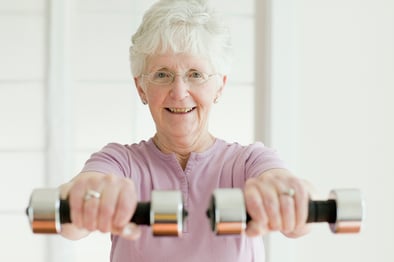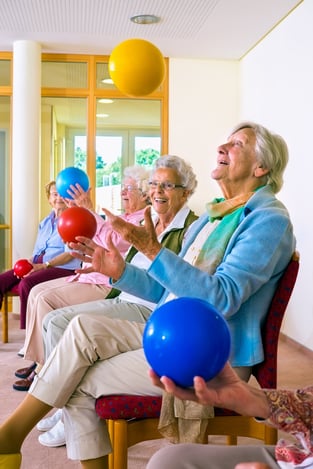According to an article in Psychology Today, one of the major reasons people tend to stop exercising after recently starting an exercise routine is that they do not want to experience discomfort. After reading this article, it made me wonder whether this is the reason some residents are more hesitant than others to incorporate exercise into their everyday lives. Investigating further into this, I had conversations with several residents about this. Some of them mentioned that they have the feeling they might be doing too much, too soon.
[Getting started: What Exercises Should I do?]
 With exercise showing benefits such as improved balance, increased total-body strength, improved cognition, and reduction of chronic illness, it is difficult to understand why people would not exercise. However, there are two reasons why I think this “too much, too soon” judgment could arise in senior fitness:
With exercise showing benefits such as improved balance, increased total-body strength, improved cognition, and reduction of chronic illness, it is difficult to understand why people would not exercise. However, there are two reasons why I think this “too much, too soon” judgment could arise in senior fitness:
- Your body has not become neuromuscularly adapted to exercise and you are engaging muscle groups that are not commonly utilized in everyday life.
- The exercise is too strenuous from overtraining, either causing strains in de-conditioned muscle groups, or potential re-injury. You can use this article from the American Council on Exercise (ACE) as a guide to determine whether you are experiencing overtraining.
Following are four tips for starting an exercise program at an older age that I provide to residents in my senior living community. Combat that “too much, too soon” feeling, and ease into the process of adding exercise to their everyday lives without overdoing it.
Monitor How You Are Feeling
A great way of measuring this is to use an RPE (Rate of Perceived Exertion) Scale to measure how hard you feel your body is working. On a scale of 0–10 (with a 0 being at complete rest, and 10 being at highest possible intensity), you should exercise within a 3 or a 4 intensity (at a moderate intensity).
Recording your heart rate after exercise is also an effective measurement of exertion. If you notice after several minutes that your heart rate is not decreasing after exercise, your body is not recovering properly.
Stop exercise if you are experiencing severe bone/joint pain, or sudden pressure in your chest, neck, shoulder, or arms.
Begin Slowly and Gradually Increase Duration/Intensity
If you are new to exercise, start out by scheduling exercises at least 2–3 times per week, for 15–20-minute sessions. As you become more physically adapted to exercise, you could increase your frequency to roughly 4–5 days per week. When you reach a point where you would like to increase your resistance and/or intensity, make sure that you make no more than a 5% increase in one week.
If you have been exercising for a while, don’t hesitate to reduce your workload to re-acclimate your body to the regular routine. This might include coming to an exercise class that is seated rather than standing, or cutting back a few minutes on your daily walk.
Plan Rest Days Accordingly
If you do not give your body the opportunity to rest in between exercise sessions, it will have physiological effects on your nervous system, and potentially develop micro-trauma and overuse injuries. You could also spend your rest and recovery days doing light stretching exercises, or going for a light walk.
Be Patient
It will take at least 3–6 weeks for your body to develop neuromuscular adaptation to exercise, and to achieve long-lasting results.
If you incorporate a slow and steady approach and find that proper balance in your exercise routine, you’ll have a higher rate of success in achieving your exercise goals and avoid a setback.
Exercise for older adults is about more than just physical fitness, grab our quickread below and read more about the importance of exercise in aging well.


 Group exercise classes are one of the top activities in senior living communities nowadays. With the increasing number of activities provided on community calendars, having a good group exercise program
Group exercise classes are one of the top activities in senior living communities nowadays. With the increasing number of activities provided on community calendars, having a good group exercise program 